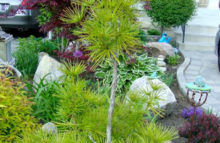| Wow, wow, WOW! The pre-sunset “golden hour” lights up butterfly weed (Asclepias tuberosa) |
Stopped in my tracks on the streets of East York. That’s the only way to describe my reaction to this plant just after 7 pm on Wednesday evening, and thank the photo gods for my iPhone. Capturing the last of the sunlight on the flowers of our native butterfly weed (Asclepias tuberosa), this image is untouched; straight out of the camera. Call me a butterfly, but I find it irresistible.
 |
| A good-sized clump, more than 24″/0.7 m. across |
This unabashed orange gal is one of the good milkweeds, not the “noxious” pink, common milkweed (Asclepias syriaca)* we’re supposed to remove from our yards.
Butterfly weed is much better behaved. It doesn’t colonize the way common milkweed does. You can see that this specimen has grown into a considerable resort for bees and butterflies. They must just go gaga.
Milkweed’s unusual, star-shaped florets are fascinating. However, till researching this, I never realized just how unique its flower structure was. In a way, insects without sipping tongues need to “put their foot in it” to pollinate the flower. Sometimes, they even get stuck. For an explanation, zip over to this excellent post by Jim Conrad of Backyard Nature.
Butterfly weed likes a well-drained soil in full sun to light shade. You can still sometimes see it growing wild on sunny slopes in undisturbed areas outside the city. It was well suited to the sandy soil of the oak savanna that was the original habitat in the Toronto area. High Park is trying to restore its oak savanna, a type of habitat which has almost completely disappeared in its natural state. I have also seen large stands of butterfly weed in the oak savanna of The Pinery provincial park on Lake Huron.
But, you don’t need a whole savanna to enjoy Asclepias tuberosa in your garden – unless you’re timid about strong colour. Look at the image below. It’s like a big sign that says, “Welcome butterflies!”
*As an aside, the flowers and buds of our plain old common milkweed are edible, according to naturalist Alan Russo. Here is his recipe for steamed milkweed buds.
[UPDATE: Asclepias tuberosa has been named Perennial Plant of the Year for 2017! A well-deserved honour for this hard-working native plant.]






8 comments
You're a butterfly. And so am I! Wow is right.
Beautiful! I love that shade of orange. I fought the common pink milkweed in a previous garden, which has put the fear of God into me about Asclepias. But hmmm…maybe I should give this one a try.
Yes, yes, and yes! This is one of my all-time favorite perennials. It also is one of the primary food plants for monarch butterfly caterpillars.
I really like this one! I have some naturally growing (not planted by me or anyone else) in our septic field across the street. Our extension agent said the other name for this beauty is 'Chigger weed' as most of the time where these lovely plants are growing, one would get chiggers if one was to try to 'acquire' said plant. 🙂
Love your photos of this pretty bloom.
Sounds like the ideal plant. It's good looking, attracts butterflies and is edible for both humans and caterpillars. Too bad it is not hardy in northern BC.
It comes up a bit late in my garden…even this year. I mark the spot so that I don't plant something else in that location.
Orange has appeared more and more in my gardens of late: geum, agastache, lilies, helenium, atlas poppies, trollius, echinaceas, crocosmia… and more.
In the spring orange geum looks lovely with Phytuma nigrum or any purple tones.
Amsonia hubrichtii develops superb orangy color come Fall that mixed with some burgundy (Angelica gigas)is a knockout. 😉
My age is showing. Never would I have considered orange and purple together..until now!
This is one of my favorite "weeds," too! Mine has taken awhile to take off, but it's gotten huge this year. Not only is it a beautiful orange, but I think the pods after the blooms have faded are pretty cool, too.
Keep an eye out for the Oleander aphid!! In one of nature's collaborative quirks, the Oleander Aphid originally from the Mediterranean likes Milkweed (Asclepias sp.). Ant colonies 'farm' the Oleander aphid by harvesting their 'honeydew', protecting them on the plant, and even storing the eggs and reintroducing them in early summer just as Butterfly weed begins flowering.
The Butterfly weed can become quite anemic as a result but is easily treated with a soapy water insect spray. Keep applying though, the ants are always restocking the 'farm'.